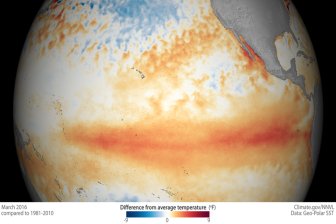The release of carbon from melting permafrost in the Arctic, in combination with a higher solar absorption by the Earth’s surface caused by melting sea ice and land snow, will accelerate climate change and have a long-term impact on the world economy, a new study from Lancaster University has revealed.

According to the study published in Nature Communications on Tuesday, the combination of the factors has the potential to increase the long-term economic impact of climate change by just under $70 trillion, under mitigation levels consistent with the current national pledges to cut carbon emissions.
The study says that is five per cent of the total cost estimated for climate change.
Under the Intergovernmental Panel on Climate Change (IPCC) Paris Agreement target of global temperature rises being limited to 1.5C from pre-industrial levels, the extra impact drops to $25 trillion, or four per cent of the total cost, the study says.
In both cases, the study revealed the primary driver behind the additional costs is the carbon emitted from thawing permafrost.
Researchers explored simulations of complex, state-of-the-art physical models to quantify the strength of the permafrost carbon feedback (PCF), driven by the additional carbon released from thawing permafrost, and of the surface albedo feedback (SAF), driven by the extra solar energy absorbed by the Earth’s surface as the white sea ice and land snow cover declines, exposing darker ocean and land.
The paper says nearly all climate policy studies to date implied a constant SAF and zero PCF.
However, researchers say recent observations and computer models show the permafrost feedback is the stronger of the two, and that both are nonlinear, with their strength changing in complex ways as the climate warms.
According to the study, this affects their impact on both the global climate and economy.
WATCH: Countries ink rules for implementing Paris Agreement (Dec. 2018)

“Arctic sea ice and land snow currently contribute around a third each to the global albedo feedback,” lead author Dmitry Yumashev of the Pentland Centre for Sustainability in Business at Lancaster University said in a statement.
“These two components are set to peak for global temperatures within the range covered by the Paris Agreement, but if the climate warms further, the summer and spring sea ice and land snow covers will retreat further north and the albedo feedback will actually weaken.”
Yumashev says the permafrost feedback grows progressively stronger in warmer climates.
“Both feedbacks are characterized by nonlinear responses to warming, including a varying lag between rising global temperature and permafrost carbon emissions,” he said.
However, the study has found that regardless of the amount of warming, using nonlinear Arctic feedbacks, compared to previous PCF and SAF values believed to be constant, leads to the increase of the total cost of climate change.
The study found the total cost of climate change associated with a 1.5C or 2C scenario is around $600 trillion. In comparison, the estimated cost associated if things remained business as usual is around $2000 trillion.
According to the findings, nonlinear PCF and SAF would add $25 trillion to the $600 trillion figure for the 1.5C scenario, and $34 trillion for the 2C scenario.
“Thus, the nonlinear Arctic feedbacks make the more ambitious 1.5C target marginally more economically attractive,” the paper reads.
Researchers say the additional price consists of mitigation costs of cutting emissions, climate adaptation costs and residual climate-related impacts.
The increases, according to the study, occur primarily through temperature-driven impacts on the economy, ecosystem, human health and additional impacts from seal level rise.
The research team say they hope their assessments will provide a better understanding of the socio-economic risks from climate change under different scenarios, and help guide policy-makers towards prudent decisions on emissions reduction targets.
“Our findings support the need for more proactive mitigation measures to keep global temperature rise well below 2C,” Yumashev said. “We hope our work will lead to further assessments of multiple nonlinear processes in the Earth’s climate system, both those associated with the Arctic and beyond.”




Comments